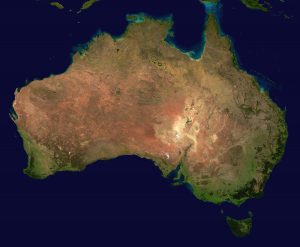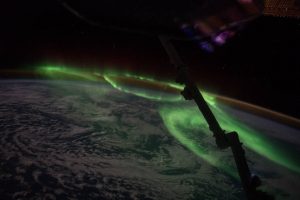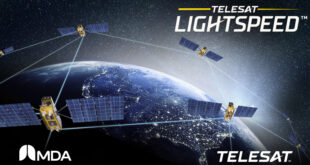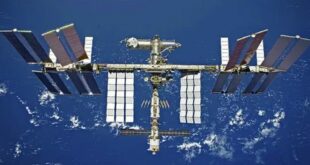So much of the coverage of what happens in national, regional, and international space activities focuses on the technical aspects of space or on high-level policy making. A growing number of individuals and organisations, however, are bridging these two very different aspects of the space sector. In Australia, Aria Stirling Colton is doing just this with her Adelaide-based National Space Innovation Hub (NSIH). Helen Jameson, the Editor-in-Chief of SpaceWatch.Global, spoke with Aria to find out more.

Can you begin by telling us a little about yourself and your background and what has brought you to the space industry?
About 14 years ago, I attended a space development conference. At that time in Australia space industry was government-led. The then President of the National Space Society asked if I could help them to raise the profile of the space industry to federal government and craft key messages so that they could talk to government, because at that point there was really no dialogue. My research into best practice in the global space industry revealed the massive opportunity of the emerging space economy and I was surprised that Australia wasn’t playing a role.
I put a three-phase proposal together entitled: The South Australian Space Initiative (SASI) for the South Australian (SA) Government to create its own space industry, recommending we create a space brand for South Australia. The first-phase was the 2006 South Australia Space Summit, which created a lot of interest, was well supported by representatives from industry, government and academia, including our own astronaut, Andy Thomas. The Findings and Recommendations were unanimously endorsed by delegates, however, the second-phase of the SASI, Space Industry development, wasn’t continued by the SA government because it seemed that the timing wasn’t right. It was too early. Nationally, there was no space policy in place and the other states and territories weren’t active in this arena.

I then went on to advise the incoming Federal Government the following year with my proposal entitled: The National Space Initiative of Australia. I gave a presentation to the incoming Minister for Industry and Innovation and this work informed space policy development and catalysed a Senate Space Inquiry into why Australia didn’t have a space industry. Aptly entitled: Lost in Space, it was held in 2008 and Submission 88 is the National Space Initiative of Australia. This is on the public record and offered recommendations and an approach to building up the Australian space industry. It was based on a great deal of research into best practice that I’d come across, looking at what other countries were doing, particularly the UK, Canada, Europe, the U.S., and Japan.
You obviously have a love of space or some space background that drives you to do this work. Is that true?
My space odyssey began as a child. I saw the blue marble hanging in space, the image called Earthrise’ and that profoundly affected me. I learned later that Earthrise was one of the iconic photos of the 20th Century, taken by Bill Anders on the 1968 Apollo 8 mission. Quoting Anders who said: “It is ironic that we went to discover the Moon, but instead we discovered the Earth.” The environment movement was born from just seeing this powerful image.

I simply could not understand why Australia wasn’t participating in the global space economy and endeavoured to get others to take notice of that – to create and develop this massive opportunity. I’m not a scientist; my perspective comes from the Arts, marketing and business. I became involved in space back in 2004, because I saw the opportunity for Australia that we needed to leverage. The writing was on the wall – we needed to transition our workforce to the jobs of the future to do that we could use space as a driver for innovation to launch new industries, education, jobs/careers and to underpin socioeconomic growth. At the time, I worked from the idea of developing a new brand, which meant bringing all the disparate elements together into a unified whole – the Team Australia approach. To me, it just made sense.
Interestingly, my background wasn’t taken as seriously as I had hoped so I enrolled in an MBA, graduating in 2016. The MBA has helped to inform my systems thinking approach to informing the development of the space industry.
What is the philosophy behind National Space Innovation Hub and what prompted you to start it up?
In February 2015, I was asked by a Minister from the previous SA government to write another proposal to get the space industry in South Australia going, which came from a presentation I gave to the SA Economic Development Board. The work was informed by previous proposals and was called the South Australian Space Initiative: Be Bold, Let’s Aim for the Stars. It was a proposal designed to guide the development of the SA Space Industry.
The National Space Innovation Hub™ (NSIH) is a vehicle to help bring the makers of space tech together with the facilitate the discussions we need to bring all elements of the space industry together and to push forward. Given the way that we are going with Space 4.0 and Industry 4.0, the time is right for an industry-led activity such as this. I realised that needed to be an industry-led activity and to be industry-focused, in partnership with government and academia.
Our planet is facing all sorts of environmental problems, and we need to be able to work together to come up with solutions, collaboratively and inclusively, transcending borders, cultures and beliefs. We celebrated Earth Day just recently so I’d like to mention the Earthrise photo, because it resonates with us more than ever today – we need to respect and protect it rather than continue in the way we have been. Space gives us a perspective of the Earth that surpasses all of these differences and unites us in a single vision for an optimistic future.
My research has shown me that space is an enabler. It makes the world a better place. I realised that we needed to become more collaborative between industry, education, business and government. Australia is really the place where we can achieve this in collaboration with our new Space Agency. Australia is known for its record of ingenuity and adaptation in response to our challenges. We have an enviable reputation, especially in sport, for punching above our weight on the world stage.

As an example, picture this: a rocket held down by rope on the back of a ute, being driven to a test site somewhere in outback Australia. That’s how the hypersonic scramjet came into existence. Dr. Allan Paull said: “You haven’t done innovation until you have driven across a country towing a rocket.” And it’s classic Aussie ingenuity! I believe we can harness this spirit to tackle space to Earth and Earth to space challenges.
I also believe we need to talk about a future where we work with the socio-economic benefits that come from space innovation, which are interwoven into the fabric of our society. Economies around the world recognise that space is a huge driver for innovation and it’s not just about launching rockets. It creates jobs and technologies and industries to benefit our society as a whole.
We also need to talk about the future we want for our kids. We want them to be inspired. Space fires the imagination and inspires students of all ages to become interested in Maths, Science, Art, Design, Technology and Engineering. The NSIH™is addressing the UN Sustainable Development Goals because there is an ethical, moral dimension to space that goes beyond the dollars. It’s about the universal, sustainable socio-economic empowerment of communities, which creates an understanding of how important the environment is to us all – and how we have treated our planet with such foolish and blatant disregard. This has to stop and common sense must prevail. The solutions to Earth’s challenges may be solved
Can we find solutions to climate change, water scarcity, urbanisation and resource depletion, using space technology? I want to find out.
The NSIH™ is developing a mechanism to harness the opportunity that space presents for inspiring the next generations, technology suppliers into the market and the end users of space applications and technology. Industry sectors that use space tech everyday include: telecommunications, agriculture, renewable energies, environmental monitoring, disaster management, mining, defence, health and medtech, education, emergency services and others. We need to make space accessible to everybody. You don’t need to be a rocket scientist to be involved in space. Our purpose is to build intellectual and social capital long term – we’re developing an ecosystem of space innovation and fostering a culture of collaboration to spin in and spin out ideas, facilitate and coordinate the makers and users, students and teachers of space tech and space stakeholders to innovate, incubate and accelerate and commercialise new tech.
What is people’s engagement like with space in Australia? Is there a collective excitement now that the Space Agency has been formed? What has the formation of a formal space agency done for the space industry in the country?
People seem to be excited that we have a Space Agency, yet many people were surprised at the announcement, assuming we already had one. They are not quite sure why we need a Space Agency and what we will be doing with space.

Image Credit: NASA
In Australia, consecutive governments have been seeking a narrative to describe innovation. Space is a huge driver for innovation and helping to drive the economy and building our own nation’s resilience to meet its future challenges. Unlike most of its international counterparts, our Space Agency is encouraging industry to take the lead and they are facilitating new business opportunities to help establish international agreements to benefit Australian industry.
The Australian Space Agency is establishing international partnerships to give us the opportunity to participate in global space activities. The formation of the Space Agency shows that space is now viewed as an industry in its own right. It’s no longer seen as a poor cousin to the defence sector, although defence is a big customer that shares similar technology and skill sets.
The space industry in Australia has arrived and the world is sitting up and taking notice. We’re the new kids on the block. The ultimate goal of our Space Agency is to triple the size of the Australian space industry by AUS$10-12 billion by 2030, generating 20,000 new jobs and to encourage students to take up STEM (or STEAM) focused careers. Australia focuses on STEM mostly however, the NSIH™ is focused upon putting the ‘A’ into STEM. We believe that the Arts and creativity go hand-in-hand with innovation and we want to have our kids performing and doing all sorts of activities in an artistic sense to convey their innovative ideas. We are just getting started on a new project at the moment with institutions that want to back us. It will be a project that will help to position Australia very well in Asia-Pacific.
Australia is no stranger to the space industry and has a thriving New Space sector today. However, in terms of policy and putting frameworks in place to enable the space industry to continue its growth, what needs to be done?
There’s still a lot of work to be done but I am really pleased to see Australia reaching out to other countries for partnerships and dialogue around best practice and with industry to set up new partnerships. The Space Agency wants industry to take the lead because they recognise that this is happening the world over. They are focused on setting up regulations, policy and strategy and helping to reduce the barriers-to-entry for the private sector. It’s great because the way it is being set up shows agility, collaboration and inclusivity.
Governments have a role to play in the innovation process but they are not innovators. The reach and scale they have create opportunities for innovation but they don’t create innovation itself. They enable and provide the incentives to encourage innovation in the private sector.
The world is on the cusp of a new way of doing business in terms of partnerships, it is the first time in history that the government space agencies are not leading. It’s so exciting to be a part of that.
When we think of the space industry in Australia, Adelaide springs to mind. Is Adelaide being set up as a ‘hub’ or do you see other towns and cities across the country adopting space as a key industry?
I have been advocating the ‘Team Australia’ approach for many years. Australia has a comparatively small population of 24 million people so states and territories need to work together collaboratively. The Space Agency recognise this and are working with all states and territories. The reason that the Space Agency has come to Adelaide in South Australia is because Adelaide put forward a very strong submission to house the Space Agency here. Because there was already so much happening in South Australia, the stage had been set, and the submission was accepted. Adelaide is also known as a test market for assessing new trends and has a vast manufacturing and defence sector here as well. South Australia is also the home of space in Australia. It’s where it all began in the 1960s so there are a few reasons why it’s here. However, the ‘Team Australia’ approach is taken very seriously and there are many activities happening around the country.
What are the near to mid-term aims of the NSIH – where do you see the Hub in five years’ time?
I see the shape and the format of the NSIH™ matching the evolving nature of the space industry itself; its challenges and the influences of new discoveries and technologies and innovation models. The NSIH™ is a place designed to make innovative, lateral thinking and cultures very welcome – and not just in cities but in the regions. We want to attract the people who have great ideas and we want to turn those great ideas into great things. Our collective space future means we are moving towards a high-growth sector that is creating opportunities and transitioning the workforce to the jobs of the future.
Our future is incredibly exciting. We’ve got massive plans to achieve our vision, working across industry sectors and leveraging our international, regional networks and partnerships. We aim to have an effective, industry-led innovation ecosystem in place to enable entrepreneurs, companies, research organisations, investors and government agencies to maximise socio-economic impact and potential research innovation. Our success factors will include access to capital, the ability to fail (which is really important) in a supportive environment and ensuring we have the regulatory environment that enables growth rather than hindering it.
Aria Stirling Colton is the Founder and Chief Executive Officer of the National Space Innovation Hub in Australia. Aria has a multidisciplinary background, which encompasses the arts, marketing and public relations, with a Masters of Business Administration (MBA) from the University of South Australia.
For more information regarding the National Space Innovation Hub, please visit the website here.
SpaceWatch.Global thanks Aria Stirling Colton, Founder And CEO of National Space Innovation Hub for the interview.





